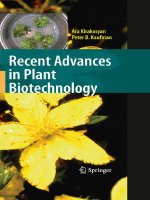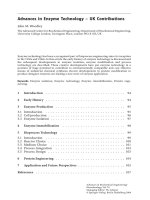Advances in enzyme biotechnology
Bạn đang xem bản rút gọn của tài liệu. Xem và tải ngay bản đầy đủ của tài liệu tại đây (4.52 MB, 179 trang )
Pratyoosh Shukla
Brett I. Pletschke
Editors
Advances
in Enzyme
Biotechnology
Advances in Enzyme Biotechnology
Pratyoosh Shukla • Brett I. Pletschke
Editors
Advances in Enzyme
Biotechnology
Editors
Pratyoosh Shukla
Department of Microbiology
Maharshi Dayanand University
Rohtak, Haryana, India
Brett I. Pletschke
Department of Biochemistry,
Microbiology and Biotechnology
Rhodes University
Grahamstown, South Africa
ISBN 978-81-322-1093-1
ISBN 978-81-322-1094-8 (eBook)
DOI 10.1007/978-81-322-1094-8
Springer New Delhi Heidelberg New York Dordrecht London
Library of Congress Control Number: 2013945175
© Springer India 2013
This work is subject to copyright. All rights are reserved by the Publisher, whether the whole or
part of the material is concerned, specifically the rights of translation, reprinting, reuse of
illustrations, recitation, broadcasting, reproduction on microfilms or in any other physical way,
and transmission or information storage and retrieval, electronic adaptation, computer software,
or by similar or dissimilar methodology now known or hereafter developed. Exempted from this
legal reservation are brief excerpts in connection with reviews or scholarly analysis or material
supplied specifically for the purpose of being entered and executed on a computer system, for exclusive
use by the purchaser of the work. Duplication of this publication or parts thereof is permitted
only under the provisions of the Copyright Law of the Publisher’s location, in its current version,
and permission for use must always be obtained from Springer. Permissions for use may be obtained
through RightsLink at the Copyright Clearance Center. Violations are liable to prosecution under
the respective Copyright Law.
The use of general descriptive names, registered names, trademarks, service marks, etc. in this
publication does not imply, even in the absence of a specific statement, that such names are
exempt from the relevant protective laws and regulations and therefore free for general use.
While the advice and information in this book are believed to be true and accurate at the date of
publication, neither the authors nor the editors nor the publisher can accept any legal responsibility
for any errors or omissions that may be made. The publisher makes no warranty, express or
implied, with respect to the material contained herein.
Printed on acid-free paper
Springer is part of Springer Science+Business Media (www.springer.com)
Foreword
This book is a collection of few recent discoveries in enzyme biotechnology
by leading researchers in Enzyme Technology and further some selected
contributions presented at the 51st Annual Conference of the Association of
Microbiologists of India (AMI-2010) which was organized at the beautiful
campus of Birla Institute of Technology in Mesra, Ranchi, India, during
December 14–17, 2010. The book is edited by Dr. Pratyoosh Shukla, one of
the executive members of the Organizing Committee and Prof. Brett I.
Pletschke from Rhodes University in Grahamstown, South Africa, who was
one of the leading invited speakers of the meeting. The meeting was attended
mainly by participants from India but was also made international by a number of invited speakers from abroad. The meeting covered various fields of
microbiology, including agricultural and soil microbiology, algal biotechnology, biodiversity, biofuel and bioenergy, bioinformatics and metagenomics, environmental microbiology, enzyme technology, and food and medical
microbiology. An important feature of the meeting was participation of
industrial researchers which contributed to fruitful interactions between
industrial and academic research indispensable for the development of new
progressive biotechnologies. The majority of chapters in the book are dedicated to industrially important enzymes modifying plant polysaccharides
and lignin. On one hand, the chapters review the current state of the art in the
areas of production and application of glycoside hydrolyses, esterases, and
lignin-degrading enzymes, while on the other hand, they describe modern
trends in the development of enzyme technologies, including the computational enzyme design and enzyme mutations. The fact that most of the chapters originate in India demonstrates rapid emergence of research activity and
enormous interest leading to the development of new enzyme technologies
in the country. As we know India is a country which is heavily populated,
and the sustainability of this country is very strongly dependent on environment friendly biotechnologies. Finally, I would also like to emphasize the
general tone of the meeting which was optimistic and enthusiastic about
emerging novel applications of enzymes and processes producing usable
energy for the future. This book also represents a powerful exposure of
important research of the present time to young researchers who filled the
v
Foreword
vi
meeting/lecture rooms. The hard work of the organizers of the meeting and
the editors of this volume is greatly appreciated.
Slovak Academy of Sciences
Institute of Chemistry, Center for Glycomics
Bratislava, Slovakia
September 11, 2012
RNDr. Peter Biely, DrSc
Preface
There has been a rapid expansion of the knowledge base in the field of
enzyme biotechnology over the past few years. Much of this expansion has
been driven by the bio-discovery of many new enzymes from a wide range
of environments, some extreme in nature, followed by subsequent protein
(enzyme) engineering. These enzymes have found a wide range of applications, ranging from bioremediation, biomonitoring, biosensor development,
bioconversion to biofuels and other biotechnologically important valueadded products, etc.
The major goal of this book is to provide the reader with an updated view
of the latest developments in the area of enzyme biotechnology. This book
presents an exceptional combination of fascinating topics and the reader will
be pleased to see that the latest technologies available for an improved understanding of enzymes are included in the book. For example, a thermostable
enzyme with sugar metabolic activity is improved by targeted mutagenesis
(Chap. 1). The reader will note that there is a significant focus on the role of
hydrolases (Chap. 2) and other depolymerising enzymes in this book, as these
enzymes form a major component of the annual revenue generated by industrial enzymes. The various other topics ranging from the synthesis of prebiotic galacto-oligosaccharides (Chap. 3), biomass-degrading enzymes, in
general, mannanases (Chap. 4), glycoside hydrolases and their synergistic
interactions (Chap. 5), manganese peroxidases (Chap. 6) to the modern trends
in experimental techniques in enzyme technology (Chap. 7) are also covered
in the present book.
Further, the most up-to-date studies related to an overview of the methodologies available for motif finding in biological sequences (Chap. 8), characteristic molecular features and functional aspects of chitin deacetylases
(Chap. 9 ), the role of enzymes in plant–microbe interactions (Chap. 10) and
the bioprospecting of industrial enzymes in various grain-processing industries (Chap. 11) have also been included.
Moreover, the readers of the book will be delighted to see that the most up
to date technologies available for a better understanding of enzymes are
included in this book to enhance the learning skills in key facets of research
in enzyme biotechnology.
vii
Preface
viii
We hope that the reader will find the information presented here valuable
and stimulating. We acknowledge and are indebted to all those who have
generously contributed to the completion of this book, and welcome comments from all those who use this book.
Haryana, India
Grahamstown, South Africa
Pratyoosh Shukla
Brett I. Pletschke
Contents
1
2
3
Improvement of Thermostable Enzyme with Sugar
Metabolic Activity by Targeted Mutagenesis .............................
Yutaka Kawarabayasi
Glycoside Hydrolases for Extraction and Modification
of Polyphenolic Antioxidants .......................................................
Kazi Zubaida Gulshan Ara, Samiullah Khan,
Tejas S. Kulkarni, Tania Pozzo, and Eva Nordberg Karlsson
On the Enzyme Specificity for the Synthesis
of Prebiotic Galactooligosaccharides ..........................................
Barbara Rodriguez-Colinas, Lucia Fernandez-Arrojo,
Miguel de Abreu, Paulina Urrutia, Maria Fernandez-Lobato,
Antonio O. Ballesteros, and Francisco J. Plou
1
9
23
4
Microbial Mannanases: Properties and Applications ...............
Hemant Soni and Naveen Kango
5
Enzyme Synergy for Enhanced Degradation
of Lignocellulosic Waste ...............................................................
J. Susan van Dyk and Brett I. Pletschke
57
Manganese Peroxidases: Molecular Diversity,
Heterologous Expression, and Applications ...............................
Samta Saroj, Pragati Agarwal, Swati Dubey, and R.P. Singh
67
6
41
7
Advance Techniques in Enzyme Research ..................................
Debamitra Chakravorty and Sanjukta Patra
89
8
Regulatory Motif Identification in Biological Sequences:
An Overview of Computational Methodologies ......................... 111
Shripal Vijayvargiya and Pratyoosh Shukla
9
Chitin Deacetylase: Characteristic Molecular
Features and Functional Aspects ................................................. 125
Nidhi Pareek, V. Vivekanand, and R.P. Singh
10
Role of Enzymes and Proteins in Plant-Microbe
Interaction: A Study of M. oryzae Versus Rice ........................... 137
Jahangir Imam, Mukund Variar, and Pratyoosh Shukla
ix
Contents
x
11
Industrial Enzyme Applications in Biorefineries
for Starchy Materials .................................................................... 147
Vipul Gohel, Gang Duan, and Vimal Maisuria
About the Editors............................ ...................................................... 175
1
Improvement of Thermostable
Enzyme with Sugar Metabolic
Activity by Targeted Mutagenesis
Yutaka Kawarabayasi
Abstract
It was well known that improvement of enzymatic activity and stability is
very difficult. For most enzymes, introduction of mutation into the amino
acid residues located within the reaction center usually disappears their
activity. Conversely, it should be useful for application of enzymes if enzymatic activity and stability are artificially enhanced. The enzyme isolated
from thermophilic archaea generally possesses absolute stability. The nucleotide-sugar molecule is a powerful material for artificial construction of
polymer structure of sugar. The ST0452 protein, an enzyme with sugar1-phosphate nucleotidylyltransferase activity from Sulfolobus tokodaii, was
chosen as target for introduction of targeted mutagenesis into the reaction
center. All mutant ST0452 enzymes exhibited the same thermostability as
shown by the parental ST0452 enzyme. Among 11 mutant ST0452 proteins
with substitution of the amino acid residues located at the reaction center by
alanine and other amino acids, five mutant ST0452 proteins showed kcat
values larger than the original value, revealing that in these mutant ST0452
proteins, reactions progress faster than the original enzyme. Even though
these mutant ST0452 proteins showed higher Km values than that of the
original enzyme, these improved mutant ST0452 proteins were capable of
exhibiting a higher activity than that of the wild-type ST0452 protein under
the presence of high concentration of substrate. These results indicate that
thermostable enzymes with higher activity were constructed from S. tokodaii
ST0452 enzyme by substitution of amino acid residues at the reaction center.
These improved enzymes are expected to be useful for application.
Keywords
Thermophilic archaea • Thermostable protein • Sugar-nucleotide •
Targeted mutagenesis • Improvement
Y. Kawarabayasi, Ph.D.
Laboratory for Functional Genomics
of Extremophiles, Faculty of Agriculture,
Kyushu University, Hakozaki 6-10-1, Higashi-ku,
Fukuoka 812-8581, Japan
National Institute of Advanced Industrial Science
and Technology (AIST), Tsukuba, Japan
e-mail:
P. Shukla and B.I. Pletschke (eds.), Advances in Enzyme Biotechnology,
DOI 10.1007/978-81-322-1094-8_1, © Springer India 2013
1
2
Introduction
Carbohydrate molecules are included within
many different types of compounds as a component: outermost structures on a microorganisms’
cellular surface which separates the cellular inner
and outer environment, source for the energy
metabolism which is important for obtaining
energy (e.g., TCA cycle), polymer structure for
storage of energy (e.g., glycogen), and heredity
molecules as a part of DNA and RNA. Also polymer form of carbohydrate molecule modifies the
function and stability of protein by binding with
the protein molecule (Udenfriend and Kodukula
1995). Many different types of modified sugar
molecules are necessary to maintain these biological processes. In most microorganisms, many
important modified sugars are synthesized from
simple sugar molecules that are incorporated into
cells from the surrounding environment.
Among modified sugar molecules, nucleotidesugar molecules play one of the most important
roles for construction of polymer structure of carbohydrate. The nucleotide-sugar, an activated
form of sugar molecule, is the sole substrate for
construction of polymer structure including a
variety of sugar molecules.
Uridine diphosphate N-acetyl-d-glucosamine
(UDP-GlcNAc) is synthesized by a four-step
reaction from fructose-6-phosphate, which is
catalyzed by glutamine:fructose-6-phosphate
amidotransferase (EC:2.6.1.16), phosphoglucosamine mutase (EC:5.4.2.10), glucosamine-1phosphate acetyltransferase (EC:2.3.1.157), and
N-acetyl-d-glucosamine-1-phosphate
uridyltransferase (EC:2.7.7.10). UDP-GlcNAc, the
final product of this biosynthetic pathway, is an
activated form of GlcNAc constructed by combination of GlcNAc-1-phosphate with UTP. This
molecule is required for constructing many kinds
of polymer structures of carbohydrates. In bacteria, UDP-GlcNAc is required for synthesis of
lipopolysaccharides, peptidoglycan, enterobacterial common antigen, and teichoic acid (Frirdich
et al. 2004; vanHeijenoort 2001; Harrington and
Baddiley 1985). In archaea, the GlcNAc moiety
is a major component of the cell surface structure
Y. Kawarabayasi
(Niemetz et al. 1997; Kandler and König 1998).
In eukarya, the activated molecule is essential for
the synthesis of chitin, a major component of the
fungal cell wall (Cabib et al. 1982), and the glycosylphosphatidylinositol linker, a molecule anchoring a variety of cell surface proteins to the plasma
membrane (Udenfriend and Kodukula 1995). The
GlcNAc moiety is found in the polycarbohydrate
structure N- or O-linked to the proteins as a
posttranslational modification (Guinez et al. 2005;
Slawson et al. 2006; Taniguchi et al. 2001; Spiro
2004). As glycosylation is the most important
modification for activating peptide drugs, UDPGlcNAc is thought to be important for future
development of effective drugs.
GlcNAc-1-P uridyltransferase activity was
identified on the thermostable ST0452 protein
from an acidothermophilic archaeon, Sulfolobus
tokodaii strain 7. The mutation was introduced
into this ST0452 enzyme for improvement of the
activity.
In this chapter, at first the feature of an acidothermophilic crenarchaeon S. tokodaii strain 7,
from which the thermostable GlcNAc-1-P uridyltransferase was isolated, will be shown. Then,
features of the enzymatic activity of this ST0452
protein and summary on the improvement of the
ST0452 protein by targeted mutagenesis will be
described.
The Feature of Thermophilic
Archaeon Sulfolobus tokodaii
strain 7
Sulfolobus tokodaii strain 7, an acidothermophilic archaeon, was used for isolation of the
enzyme with the sugar-1-phosphate nucleotidylyltransferase activity. This microorganism was
isolated from Beppu hot springs located at
Kyushu in Japan (Suzuki et al. 2002). As this
microorganism was isolated from hot spring,
the microorganism is able to grow between
70 °C and 85 °C and between pH 2.5 and 5.0
with the optimal growth condition at 80 °C
and 2.5–3.0, respectively. This microorganism
was isolated from the geothermal environment;
thus, this microorganism can grow under aerobic
1
Improvement of Thermostable Enzyme with Sugar Metabolic Activity by Targeted Mutagenesis
condition. The phylogenetic analysis showed that
this microorganism is included in the kingdom
Crenarchaeota of the domain Archaea. The
microorganism grows chemoheterotrophically
under aerobic respiration condition. Autotrophic
growth of this microorganism was not observed
in minimal media supplied with elemental sulfur,
although several strains isolated as genus Sulfolobus
are known to be capable of growing autotrophically.
Phylogenetic analysis by 16S rDNA sequences
indicated that the sequence of this microorganism is most closely related to that of Sulfolobus
yangmingensis (Suzuki et al. 2002).
The entire genomic sequence of S. tokodaii
was already determined (Kawarabayasi et al.
2001). The size of the genome of S. tokodaii is
2,694,756 bp long, and the G+C content is
approximately 32.8 %. Within this genomic
sequence, over 2,800 open reading frames
(ORFs) were predicted as potential proteincoding regions, and 32.2 % of these are predicted of their functions (annotatable), 32.6 %
of these are related to the conserved but
unknown ORFs, and 5.1 % of these contain
some motif sequences. Among 46 tRNA genes
predicted within the genomic sequence, 24
tRNA genes are shown as the interrupted tRNA
genes which contain the intron within their
genes. The CCA sequence is required for binding with amino acid, and this CCA sequence is
not included in most tRNA genes predicted in
this genomic sequence of S. tokodaii. Also the
tRNA nucleotidylytransferase, which is used for
addition of CCA sequence posttranscriptionally,
was predicted on the genomic sequence of S.
tokodaii. These features are closely similar to
that of eukaryote.
Already entire genomic sequences of two
similar species, Sulfolobus solfataricus and
Sulfolobus acidocaldarius, were determined (She
et al. 2001; Chen et al. 2005). The genome size
and the number of the predicted protein-coding
regions of S. solfataricus and S. acidocaldarius
are 2,992,245 bp and 2,977 and 2,225,959 bp and
2,292, respectively. Among these potential
protein-coding regions, approximately 1,600
genes are conserved within three Sulfolobus
species. Approximately from 400 to 900 genes
3
are predicted as that present only in one species
(Chen et al. 2005).
The genomic data of S. tokodaii was used for
identification of the useful enzymes. In the following sections, a brief identification of the
enzyme with sugar-1-phosphate nucleotidylyltransferase activity and improvement of the useful activity are indicated.
Sugar Metabolic Enzyme from
an Acidothermophilic Archaeon,
S. tokodaii
Although many gaps are remaining in the metabolic pathway constructed from the genomic data
of S. tokodaii, the four genes for TDP-rhamnose
biosynthesis pathway from glucose-1-phosphate
and TTP were predicted from the genomic data of
S. tokodaii. Also, genes similar to the first enzyme
in this biosynthetic pathway, glucose-1-phosphate
thymidylyltransferase, were detected on the
genome. Among these genes located at other
position than the first enzyme within the TDPrhamnose biosynthesis pathway, the ST0452 gene
was chosen for analysis of its activity and function,
because of the presence of the long C-terminal
domain which was not present in the other similar
genes. Thus, the gene encoding the ST0452 protein
was cloned and expressed in E. coli. As shown in
Fig. 1.1, the forward and reverse direction of Glc1-phosphate thymidylyl-transferase activity was
detected on the purified ST0452 protein. The protein exhibited utilization of multiple metal ions,
absolute thermostability with retaining 50 % of
maximum activity after 180 min treatment at 80 °C,
and relative high activity from pH 5.0 to 8.5 with
maximum activity at pH 7.5 (Zhang et al. 2005).
By analysis of substrate specificity, it was indicated that multiple sugar-1-phosphate and NTP
plus dNTP substrates were acceptable for the
sugar-1-phosphate nucleotidylyltransferase activity of the ST0452 protein as shown in Table 1.1.
Among these, GlcNAc-1-phosphate uridyltransferase activity was one of the most important
sugar-1-phosphate nucleotidylyltransferase activities, because the GlcNAc moiety is usually found
at the most fundamental position of polysaccharide.
Y. Kawarabayasi
4
a
TTP
b
c
TDP-glucose
d
TTP
TDP-glucose
TDP-Glucose
Substrate
ST0452 protein
UTP
GlcNAc-1-P
E. coli enzymeb
UTP
GlcNAc-1-P
Kma
kcata
1.00
4.65
1.00
0.72
9.83
10.40
6.80
5.95
a
The relative values are expressed as a proportion of that
detected on UTP and the ST0452 protein
b
The kinetic parameters for E. coli enzyme is according to
the results described by Gehring et al. (1996)
TTP
Fig. 1.1 HPLC elution profile of the products by glucose1-phosphate nucleotidylyltransferase activity of the
ST0452 protein. The HPLC elution profiles for the products before (a and c) and after (b and d) incubation for
20 min at 80 °C with the ST0452 protein. The glucose-1phosphate was added into the reaction solution as substrate (a and b), and TDP-glucose and PPi were added as
substrates (c and d) for proceeding the reaction
Table 1.1 Substrate specificity of the sugar-1-phosphate
nucleotidylyltransferase activity of the ST0452 protein
Substrate B
Substrate A
dTTP
d-Glucose-1-phosphate
dATP
dCTP
dGTP
UTP
ATP/CTP/GTP
dTTP
N-Acetyl-d-glucosamine-1phosphate
d-Glucosamine-1-phosphate
d-Galactose-1-phosphate
d-Mannose-1-phosphate
UTP
N-Acetyl-d-glucosamine-1phosphate
d-Glucosamine-1-phosphate
d-Galactose-1-phosphate
d-Mannose-1-phoqsphate
Table 1.2 Kinetic properties for the N-acetyl-dglucosamine-1-phosphate uridyltransferase activity of the
ST0452 protein
Relative
activity
100
35
7
1
130
NDa
320
NDa
NDa
NDa
540
NDa
NDa
NDa
a
ND: not detected
Therefore, this activity was expected to catalyze
the last reaction in the UDP-GlcNAc biosynthesis
pathway from fructose-6-phosphate.
The kinetic parameters for the GlcNAc-1phosphate uridyltransferase activity of the ST0452
protein were obtained. Compared with those of
the similar enzyme in E. coli, both Km and kcat
values for this activity of the ST0452 protein are
lower than those of E. coli as shown in Table 1.2.
It means that the ST0452 protein is capable of
binding with low concentration of substrates, but
the turnover rate of reaction is slower than that of
the similar E. coli enzyme. The low turnover rate
is not convenient for production of nucleotidesugar molecules in application.
Conversely, thermostability is beneficial for
industrial application; therefore, it was attempted
to increase the sugar-1-phosphate nucleotidylyltransferase activity, especially GlcNAc-1-phosphate
uridyltransferase activity, of the ST0452 protein.
Improvement of the Archaeal
Enzymatic Activity by Targeted
Mutagenesis
For increase of the sugar-1-phosphate nucleotidylyltransferase activity of the ST0452 protein, the
substitution of amino acid residues without diminishing the thermostability was planned fundamentally according to the expectation that the
substitution of the amino acid residues located
within the reaction center should not affect the
thermostability of the protein, because the reaction center is allocating at the relatively inside of
the protein like a pocket. Thus, it was expected
that the substitution of the amino acid residues
within the reaction center should not affect the
overall structure and thermostability of the protein.
1
Improvement of Thermostable Enzyme with Sugar Metabolic Activity by Targeted Mutagenesis
Thr80
Tyr97
Glu146
Asp208
Gly9
Asp99
Lys147
Arg13
Lys23
Arg21
Leu14
Fig. 1.2 Proposed 3D structure of the sugar-1-phosphate
nucleotidylyltransferase reaction center of the ST0452
protein. The amino acid residues participating in binding
with nucleoside triphosphate substrates, sugar-1phosphate substrates, N-acetyl portion of GlcNAc-1phosphate, and metal ions are indicated by red, blue,
green, and magenta, respectively. The region from Leu14
to Arg21 indicating high conservation with the corresponding sequences of E. coli RmlA is indicated by cyan.
The metal ion is indicated by brown
Therefore, the substitution of the amino acid
residues located around the reaction center was
attempted. As shown in Fig. 1.2, the amino acid
residues, shown by color character, surrounding
the reaction center of the ST0452 were changed to
alanine or other amino acid. Total 11 mutant
ST0452 proteins were constructed as shown in
Fig. 1.3. Analysis of the thermostability of these
mutant ST0452 proteins, SDS-polyacrylamide
gel electrophoresis of these proteins after treatment at 80 °C for 30 min, indicated that thermostability of all mutant ST0452 proteins was not
affected by substitution of the amino acid residues
within reaction center (Fig. 1.4). As all mutant
ST0452 proteins exhibited same thermostability
as parental wild-type ST0452 protein as expected,
all mutant ST0452 proteins were used for detailed
analyses of their sugar-1-phosphate nucleotidylyltransferase activity (Zhang et al. 2007).
Relative values of kinetic parameters for
GlcNAc-1-phosphate uridyltransferase activity
of the mutant ST0452 proteins are shown in
5
Table 1.3. It indicated that five mutant ST0452
proteins exhibited higher kcat values than parental wild-type ST0452 protein. However, the Km
values for the GlcNAc-1-phosphate uridyltransferase activity of these mutant ST0452 proteins
also changed to more larger than that of the wildtype ST0452 protein as shown in Table 1.3. These
results revealed that these mutant ST0452 proteins required higher concentration of substrate
for efficient binding, but reaction proceeds faster
than wild-type ST0452 protein. Thus, their
activities under presence of the high concentration of substrate were analyzed. The results
indicated that when high concentration of
GlcNAc-1-phosphate and UTP were supplied
into the reaction mixture, five mutant ST0452
proteins exhibited the higher relative activities
than that of the parental wild-type ST0452 protein (Fig. 1.5). The result revealed that the substitution of the amino acid residues within reaction
center by alanine or other amino acid is effective
and useful for improvement of the enzyme with
the GlcNAc-1-phosphate uridyltransferase activity from an acidothermophilic archaeon S. tokodaii. As similar results were obtained from other
enzymes isolated from S. tokodaii (data not
shown), it can be said that this exclusive feature
is common for proteins in this microorganism.
The amino acid residues effective for improvement of kcat values of the GlcNAc-1-phosphate
uridyltransferase activity of the ST0452 protein
by target mutagenesis were shown by enclosure
of red lines in Fig. 1.6. These effective residues
are located at relatively apart from the reaction
center. Thus, it is thought from improvement of
the activity of the ST0452 protein, that the amino
acid residues located relatively surrounding the
area of the reaction center should play an important role for the turnover rate of the activity.
Discussion and Perspective
Some number of improvements of enzymatic
activity was already reported (Sun et al. 2011;
Qi et al. 2012). However, targets of these experiments
are enzymes from mesophilic microorganism.
Therefore, the result shown for the ST0452
Y. Kawarabayasi
6
EcRmlA
ST0452 protein
EcGlmU
12 GSGTRLHPA T L A V S K 26
9 GSGERLEPI T H T R P K 23
14 GKGTRMY-- S - D L P K 25
83 Q P S - P D G L 89
73 Q K D D I K G T 80
76 Q A E - Q L G T 82
L
EcRmlA
ST0452 protein
EcGlmU
107 LVL-GDN 112
94 LIIYGDL 100
99 LMLYGDV 106
160 L E E- K P L E P K S N 170
144 I I E - K P E I P P S N 154
152 I V E H K D A T D E Q R 163
F
EcRmlA
ST0452 protein
EcGlmU
220 RGYAWLDTG 228
202 EGY-WMDIG 210
222 EVEG-VNNR 229
Fig. 1.3 Sequence alignment of five highly conserved
domains among the ST0452 protein and E. coli glucose1-phosphate thymidylyltransferase and N-acetyl-dglucosamine-1-phosphate uridyltransferase. EcRmlA
and EcGlmU indicate the glucose-1-phosphate thymidylyltransferase from E. coli (GenBank accession number P37744) and N-acetyl-d-glucosamine-1-phosphate
uridyltransferase from E. coli (NC_000913). The letters
within boxes indicate the residues conserved within
three proteins. The amino acid residues chosen for the
construction of mutant proteins are indicated by symbol, and amino acid residues introduced into the mutant
ST0452 proteins other than alanine are shown below
symbols. The numerals indicate the coordinates of the
two ends of each domain from the N-terminus of each
protein
Table 1.3 Kinetic properties for the N-acetyl-dglucosamine-1-phosphate uridyltransferase activity of the
wild-type and mutant ST0452 proteins
Fig. 1.4 SDS-PAGE analysis of the mutant ST0452 proteins produced in E. coli. The wild-type and mutant
ST0452 proteins expressed in E. coli were subjected to the
12 % of polyacrylamide gel containing 0.1 % of SDS after
treatment at 80 °C for 20 min. Lane M: lane for molecular
marker
protein was thought to be the first result of
improvement of thermostable enzyme.
The results described in this chapter propose
the opportunity that activity of the thermostable
protein is able to be improved by introduction of
the targeted mutagenesis at the amino acid residues allocating around the reaction center. If it is
general for the thermostable proteins from archaea,
it is convenient for application in industry to provide an enzymatic activity with high turnover rate
by introduction of targeted mutagenesis. Therefore,
it is planned to attempt to check this possibility for
Proteins
ST0452
G9A
R13A
K23A
T80A
T80L
Y97A
Y97F
D99A
E146A
K147A
D208A
Km for UTP
1.00
5.88
1.00
1.53
1.59
8.24
8.24
8.82
0.94
2.94
1.65
3.88
Km for
GlcNAc-1-P
1.00
271.25
193.75
833.75
43.75
443.75
8.25
4.63
1107.5
386.25
312.50
58.75
kcat
1.00
4.07
0.80
0.05
1.51
0.30
2.11
4.95
0.012
0.73
3.23
0.74
The relative values are showed as a proportion of that
detected on the wild-type protein
many target proteins from thermophilic archaeal
species. If this feature will be detected on many
target proteins, introduction of this type of mutation will become a powerful tool for improving the
thermostable enzymes isolated from thermophilic
archaea. This will be helpful for making a constitutively developing society in this planet for the
next generation.
1
Improvement of Thermostable Enzyme with Sugar Metabolic Activity by Targeted Mutagenesis
7
250
Relative activity (%)
200
150
100
50
D
A
A
7
14
8
20
K
A
46
E1
7F
Y9
7A
Y9
0A
T8
9A
3A
R1
G
52
04
ST
Fig. 1.5 N-Acetyl-d-glucosamine-1-phosphate uridyltransferase activity of the mutant ST0452 proteins
under three different conditions. N-acetyl-d-glucosamine1-phosphate uridyltransferase activities of each mutant
protein indicated were measured in the reaction solution with 5 μM UTP plus 50 μMN-acetyl-d-glucosamine1-phosphate (open bars), 100 μM UTP plus 50
μMN-acetyl-d-glucosamine-1-phosphate
(hatched
bars), and 100 μM UTP plus 10 mMN-acetyl-dglucosamine-1-phosphate (closed bars). The relative
activity is expressed as a percentage of the activity
detected on the wild-type ST0452 protein under the
condition containing 100 μM UTP plus 10
mMN-acetyl-d-glucosamine-1-phosphate
Acknowledgements I appreciate five postdoctoral fellows,
Tsujimura M., Zhang Z., Akutsu J., Sasaki M., and Md. M.
Hossain, working in my laboratory for research in this area.
This work was financially supported by special grants for the
Protein 3,000 project, a basic knowledge project by New
Energy and Industrial Technology Development Organization
and a Grant-in-Aid for Research of the Ministry of Education,
Culture, Sports, Science and Technology.
Thr80
Tyr97
Glu146
Asp208
Gly9
Asp99
Lys147
References
Arg13
Lys23
Arg21
Leu14
Fig. 1.6 Proposed 3D structure of the sugar-1-phosphate
nucleotidylyltransferase reaction center of the ST0452
protein with marking of the amino acid residues working
as improving its activity by substitution. The colored
amino acid residues are shown as legend of Fig. 1.2. The
amino acid residues important for improving the sugar-1phosphate nucleotidylyltransferase activity of the ST0452
are enclosed by red lines
Cabib E, Roberts R, Bowers B (1982) Synthesis of the
yeast cell wall and its regulation. Annu Rev Biochem
51:763–793
Chen L, Brügger K, Skovgaard M, Redder P, She Q,
Torarinsson E, Greve B, Awayez M, Zbat A, Klenk HP,
Garrett RA (2005) The Genome of Sulfolobus acidocaldarius, a model organism of the Crenarchaeota.
J Bacteriol 187:4992–4999
Frirdich E, Vinogradov E, Whitfield C (2004) Biosynthesis
of a novel 3-deoxy-d-manno-oct-2-ulosonic acidcontaining outer core oligosaccharide in the lipopolysaccharide of Klebsiella pneumoniae. J Biol Chem
279:27928–27940
Gehring AM, Lees WJ, Mindiola DJ, Walsh CT, Brown
ED (1996) Acetyltransfer precedes uridylyltransfer
in the formation of UDP-N-acetylglucosamine in
8
separable active sites of the bifunctional GlmU protein
of Escherichia coli. Biochemistry 35:579–585
Guinez C, Morelle W, Michalski JC, Lefebvre T (2005)
O-GlcNAc glycosylation: a signal for the nuclear
transport of cytosolic proteins?.Int J Biochem Cell
Biol 37: 765–774
Harrington CR, Baddiley J (1985) Biosynthesis of wall
teichoic acids in Staphylococcus aureus H, Micrococcus
varians and Bacillus subtilis W23. Involvement of
lipid intermediates containing the disaccharide
N-acetylmannosaminyl N-acetylglucosamine. Eur
J Biochem 153:639–645
Kandler O, König H (1998) Cell wall polymers in Archaea
(Archaebacteria). Cell Mol Life Sci 54:305–308
Kawarabayasi Y, Hino Y, Horikawa H, Jin-no K, Takahashi
M, Sekine M, Baba S, Ankai A, Kosugi H, Hosoyama A,
Fukui S, Nagai Y, Nishijima K, Otsuka R, Nakazawa H,
Takamiya M, Kato Y, Yoshizawa T, Tanaka T, Kudoh
Y, Yamazaki J, Kushida N, Oguchi A, Aoki K,
Masuda S, Yanagii M, Nishimura M, Yamagishi A,
Oshima T, Kikuchi H (2001) Complete genome
sequence of an aerobic thermoacidophilic crenarchaeon, Sulfolobus tokodaii strain7. DNA Res
8:123–140
Niemetz R, Kärcher U, Kandler O, Tindall BJ, König H
(1997) The cell wall polymer of the extremely
halophilic archaeon Natronococcus occultus. Eur
J Biochem 249:905–911
Qi X, Guo Q, Wei Y, Xu H, Huang R (2012) Enhancement
of pH stability and activity of glycerol dehydratase
from Klebsiella pneumoniae by rational design.
Biotechnol Lett 34:339–346
She Q, Singh RK, Confalonieri F, Zivanovic Y, Allard G,
Awayez MJ, Chan-Weiher CCY, Curtis BA, Moors
AD, Erauso G, Fletcher C, Gordon PMK, Heikamp-de
Jong I, Jeffries AC, Kozera CJ, Peng X, Thi-Ngoc HP,
Redder P, Schenk ME, Theriault C, Theriault C,
Tolstrup N, Charlebois RL, Doolittle WF, Douguest
M, Gaasterland T, Garrett RA, Ragan MA, Sensen
CW, van der Oost J (2001) The complete genome of
the crenarchaeon Sulfolobus solfataricus P2. Proc Natl
Acad Scie USA 98:7835–7840
Y. Kawarabayasi
Slawson C, Housley MP, Hart GW (2006) O-GlcNAc
cycling: how a single sugar post-translational modification is changing the way we think about signaling
networks. J Cell Biochem 97:71–83
Spiro RG (2004) Role of N-linked polymannose oligosaccharides in targeting glycoproteins for endoplasmic
reticulum-associated degradation. Cell Mol Life Sci
61:1025–1041
Sun Y, Yang H, Wang W (2011) Improvement of the thermostability and enzymatic activity of cholesterol oxidase by site-directed mutagenesis. Biotechnol Lett
33:2049–2055
Suzuki T, Iwasaki T, Uzawa T, Hara K, Nemoto N,
Kon T, Ueki T, Yamagishi A, Oshima T (2002)
Sulfolobus tokodaii sp. nov. (f. Sulfolobus sp.
strain 7), a new member of the genus Sulfolobus isolated from Beppu Hot Springs, Japan. Extremophiles
6:39–44
Taniguchi N, Ekuni A, Ko JH, Miyoshi E, Ikeda Y, Ihara
Y, Nishikawa A, Honke K, Takahashi M (2001)
A glycomic approach to the identification and characterization of glycoprotein function in cells transfected with glycosyltransferase genes. Proteomics
1:239–247
Udenfriend S, Kodukula K (1995) How glycosylphosphatidylinositol-anchored membrane proteins are
made. Annu Rev Biochem 64:563–591
vanHeijenoort J (2001) Formation of the glycan chains in
the synthesis of bacterial peptidoglycan. Glycobiology
11:25R–36R
Zhang Z, Tsujimura M, Akutsu J, Sasaki M, Tajima H,
Kawarabayasi Y (2005) Identification of an extremely
thermostable enzyme with dual sugar-1-phosphate
nucleotidyltransferase activities from an acidothermophilic archaeon, Sulfolobus tokodaii strain 7. J Biol
Chem 280:9698–9705
Zhang Z, Akutsu J, Tsujimura M, Kawarabayasi Y
(2007) Increasing in archaeal GlcNAc-1-P uridyltransferase activity by targeted mutagenesis while
retaining its extreme thermostability. J Biochem
141:553–562
2
Glycoside Hydrolases
for Extraction and Modification
of Polyphenolic Antioxidants
Kazi Zubaida Gulshan Ara, Samiullah Khan,
Tejas S. Kulkarni, Tania Pozzo,
and Eva Nordberg Karlsson
Abstract
Antioxidants are important molecules that are widely used by humans,
both as dietary supplements and as additives to different types of products.
In this chapter, we review how flavonoids, a class of polyphenolic antioxidants that are often found in glycosylated forms in many natural resources,
can be extracted and modified using glycoside hydrolases (GHs).
Glycosylation is a fundamental enzymatic process in nature, affecting
function of many types of molecules (glycans, proteins, lipids as well as
other organic molecules such as the flavonoids). Possibilities to control
glycosylation thus mean possibilities to control or modify the function of
the molecule. For the flavonoids, glycosylation affect both the antioxidative power and solubility. In this chapter we overview results on in vitro
deglycosylation and glycosylation of flavonoids by selected GHs. For
optimal enzymatic performance, desired features include a correct specificity for the target, combined with high stability. Poor specificity towards
a specific substituent is thus a major drawback for enzymes in particular
applications. Efforts to develop the enzymes as conversion tools are
reviewed.
Keywords
Glucosidase • Cellulase • Amylase • Glycosynthase • GH • Flavonoid •
Quercetin
Introduction
K.Z.G. Ara • S. Khan • T.S. Kulkarni • T. Pozzo
• E. Nordberg Karlsson (*)
Biotechnology, Department of Chemistry,
Lund University, P.O. Box 124,
SE-22100 Lund, Sweden
e-mail:
The increased concern about scarcity of fossil
resources has lately put the use of renewable
resources by biotechnological methods in focus,
as these are predicted to have an increased importance in production of food, additives and chemicals. Antioxidants can be foreseen to play a role as
P. Shukla and B.I. Pletschke (eds.), Advances in Enzyme Biotechnology,
DOI 10.1007/978-81-322-1094-8_2, © Springer India 2013
9
10
K.Z.G. Ara et al.
bio-based ingredients in food (as well as other)
products, both as preservatives, replacing agents
with negative health aspects, and as nutraceuticals.
Flavonoids are polyphenolic compounds and a
class of secondary metabolites that are widely distributed in nature. The beneficial properties of flavonoids are mainly referred to their ability to
counteract oxidative stress caused by oxygen species and metal ions (Lin and Weng 2006; Havsteen
2002), and they are shown to play a protective role
against neoplasia, atherosclerosis and neurodegenerative diseases (Lee and Lee 2006; Boudet 2007).
Because of these exclusive properties, flavonoids
have received great attention and the industrial
interest is growing rapidly. Apart from this role,
antioxidants can also be added to food and other
types of products to prolong their shelf-life.
Currently over 6,500 flavonoids have been identified (Corradini et al. 2011), and they are commonly
found in plants, fruits, vegetables, ferns, stems,
roots, tea, wine and also from bark (Nijveldt et al.
2001). Their role in plants is to protect against
UV-radiation diseases, infections and insect invasion (Corradini et al. 2011). The content of flavonoids varies, dependent on the source, but is
normally in the mg-range per kg raw material. For
example, the content of the flavonoid quercetin is
around 300 mg/kg of onion (Griffiths et al. 2002),
100 mg/kg of broccoli, 50 mg/kg of apples, 40 mg/kg
of blackcurrants and 30 mg/kg of green tea
(Hollman and Arts 2000).
Problems with many flavonoids are, however,
low solubility and poor stability (in both polar
and nonpolar media) which make their uses
difficult in many formulations of food, pharmaceutical and nutraceutical products (Ishihara and
Nakajima 2003). Improvement of the hydrophilic
nature, biological properties and stability of flavonoids can be achieved by enzymatic structural
modification (Haddad et al. 2005). In nature,
enzyme function has however evolved according
to the conditions in the living cells and may not
be perfect in specific biotechnological applications. In this chapter, we review the current use of
glycoside hydrolases (GHs) in flavonoid extractions and conversions along with efforts to
develop GHs (especially β-glucosidase and endoglucanase) for deglycosylation and glycosylation
of these polyphenolic compounds.
The core structure of a flavonoid is 2-phenyl
benzopyranone, also known as 2-phenyl-1,
4-benzopyrone (Fig. 2.1), in which the three-carbon
bridge between phenyl groups is cyclised with
oxygen (Corradini et al. 2011). Flavonoids are
divided into flavones, isoflavones, flavonols, flavanones, flavan-3-ols and anthocyanidins based
on their degree of unsaturation and oxidation of
the three-carbon segment (Hughes et al. 2001)
(Table 2.1). They are generally found as glycosidic conjugates with sugar residues, and
sometimes they can also exist as free aglycones
(Stobiecki et al. 1999). For example, quercetin
exists mostly in the form of glycosides (Fig. 2.1).
Fig. 2.1 General structure of the flavonoid backbone
(left), shown with backbone numbering. The most common hydroxyl positions for glycosylation (3 and 7) are
indicated with black arrows, and the 5 and 4′ hydroxyls
that are sometimes glycosylated are indicated with grey
arrows. A quercetin molecule (right) is also shown with
the substituents present in this type of flavonoid. R and R′
are hydrogens in the deglycosylated form. In glycosylated
forms isolated from onion, R and/or R′ represents glucosyl groups
Structural Overview of Flavonoids
and Different Flavonoid Glycosides
2
Glycoside Hydrolases for Extraction and Modification of Polyphenolic Antioxidants
11
Table 2.1 Chemical structures of subclasses of flavonoids
Flavonol
Quercetin
Kaempferol
Myricetin
Isorhamnetin
R1
OH
H
OH
OMe
Flavone
Apigenin
Luteolin
R1
H
OH
Flavanones
Eriodictyol
Hesperetin
Naringenin
R1
OH
OH
H
Flavan-3-ols
(+) Catechin
R1
H
Anthocyanidin
Cyanidin
Delphinidin
Malvidin
Petunidin
R1
OH
OH
OMe
OMe
R2
H
H
OH
H
R2
OH
OMe
OH
R2
H
OH
OMe
OH
The addition of the glycoside conjugates or glycosylation makes the flavonoid less reactive and
more polar, leading to higher water solubility.
Hence, this is the most important modification
that occurred in plants to protect and store the fla-
vonoids in the cell vacuole (Cuyckens et al.
2003). The development of flavonoid-O-glycosides
includes one or more of the aglycone hydroxyl
groups bound to a sugar with formation of an
O-C acid-labile acetal bond. The glycosylation
12
does not occur in each hydroxyl groups but in
certain favoured positions: 3- and 7-hydroxyls
are common glycosylation sites, but glycosylations are also reported at 5-hydroxyls in anthocyanidins and 4′-hydroxyls in the flavonol
quercetin (Cuyckens et al. 2003; Iwashina 2000;
Robards et al. 1997). The most encountered sugar
is glucose, followed by galactose, arabinose,
rhamnose and xylose, while glucuronic and
galacturonic acids are quite rare. Further, some
disaccharides are also found in conjugation with
flavonoids, like rutinose (6-O-L-rhamnosyl-dglucose) and neohesperidose (2-O-L-rhamnosyld-glucose) (Robards et al. 1997).
Glycoside Hydrolases
as Extraction Aids
By-products from agriculture, food and forest
industries have the potential to become a major
source of flavonoids. Isolation of the polyphenolic compounds from the plant sources is usually
K.Z.G. Ara et al.
done by using different extraction methods
(Fig. 2.2). In processing of renewable resources
such as agricultural by-products or bark, enzymatic hydrolysis can be coupled with the extraction process, and GHs (sometimes also termed
glycosidases) are commonly used for these purposes. These enzymes are generally easy to handle, as they do not require cofactors and they can
be used at an early stage on the readily available
material found in the forest and agricultural sectors (Turner et al. 2007). GHs are hydrolases
responsible for the transfer of glycosyl moieties
from a donor sugar to an acceptor and have either
an inverting or retaining (Fig. 2.3) reaction
mechanism, and in hydrolysis the acceptor is
water (Ly and Withers 1999). The hydrolysed
glycosidic bond can be located between two or
more carbohydrates (e.g. polysaccharides) but
also between a carbohydrate and a non-carbohydrate moiety (e.g. glycosylated antioxidants). In
these types of applications, enzymes can (dependent on their specificity) thus be used both in
pretreatment of the raw materials – acting on the
Fig. 2.2 Schematic overview of an extraction process to obtain antioxidants with desired glycosylation patterns. The
possibilities to use glycoside hydrolases in pretreatment and in conversions to modify the glycosylation are indicated
2
Glycoside Hydrolases for Extraction and Modification of Polyphenolic Antioxidants
13
Fig. 2.3 The double displacement mechanism of retaining glycoside hydrolases. HO-R1 represents the group
cleaved from the donor substrate, while HO-R2 represents
the acceptor molecule. The covalent glycosyl-enzyme
intermediate is boxed. For hydrolysis reactions HO-R2 is
a water molecule and R2=H
polysaccharide fibres to simplify release of the
secondary metabolites (the antioxidants) in the
following extraction (Fig. 2.2) but also to change
the glycosylation pattern (described in more
detail in section “Glycoside Hydrolases in
Flavonoid Conversions”) on the polyphenolic
products. Pretreatment with different types of
polysaccharide-degrading glycoside hydrolases
[cellulases, hemicellulases (e.g. xylanases and
mannanases) and pectinases] before the extraction has, for example, been reported to promote
release of the desired secondary metabolite flavonoids from matrices of different sources containing complex polysaccharides (Fu et al. 2008;
Kapasakalidis et al. 2009; Landbo and Meyer
2001; Lin et al. 2009; Maier et al. 2008; Zheng
et al. 2009). Sources investigated include fruits
and berries, e.g. apples (Zheng et al. 2009),
blackcurrants (Landbo and Meyer 2001) and
grapes (Maier et al. 2008), but also agricultural
products such as pigeon peas (Fu et al. 2008)
or products from forestry, such as pine (Lin
et al. 2009).
glycosylated flavonoids. Extractions from biomass
often benefit from high-temperature processing, as
this aids in loosening recalcitrant polysaccharide
fibre structures. A step in this direction is also
taken in flavonoid extractions, in which novel
technologies striving to increase the environmental performance have been used that replace traditionally used extraction solvents (e.g. methanol
and where deglycosylation is made by acid) with
pressurised hot water where deglycosylation is
made in an enzymatic step (Turner et al. 2006;
Lindahl et al. 2010). The high-temperature extraction method puts in a need of a thermostable
enzyme, which in this case was obtained from a
thermophilic microorganism (Thermotoga neapolitana) but which also can be developed from
enzymes originally active at ambient temperatures
by mutagenesis. In the latter case, both rational
and random methods have been utilised, but due to
relatively straight forward screening possibilities
(often relying on incubations and activity assays at
the desired temperature), different random strategies are frequently utilised (Fig. 2.4). Successful
combinatorial designs for enhanced (thermal)
stability development have, for instance, been
reviewed by Bommarius et al. (2006).
Development of Thermostability:
A Means to Improve GHs as
Extraction Aids
Thermostable GHs have been well documented for
use in low-value, high-volume applications, such
as starch degradation and the conversion of lignocellulosics (Turner et al. 2007), but they are still
relatively rarely used in extractions/conversions of
Glycoside Hydrolases in Flavonoid
Conversions
Use of GHs as specific catalysts to modify the
substituents on the target product is currently
also gaining attention. Taking advantage of the
K.Z.G. Ara et al.
14
Fig. 2.4 Strategies for mutagenesis of enzymes by rational and random methodologies
possibilities to utilise retaining enzymes for both
synthesis and hydrolysis, GHs can be used to
either remove glycoside substituents (by hydrolysis using water as acceptor) or to add substituents (using in this case flavonoid acceptor
molecules) (Fig. 2.3). Hydrolases express catalytic activity also in media with low water content such as organic solvents (resulting in less
competition with water as acceptor molecule)
and may under these conditions catalyse new
reactions (Klibanov 2001). GHs however work
rather poorly in organic media (compared to
other hydrolytic enzymes, e.g. lipases) due to the
requirement of higher thermodynamic water
activity (Ljunger et al. 1994). The reasons for this
are largely unknown, but indicate that water molecules have a role in interactions between substrate and enzyme. Use of thermostable GHs,
when organic media are used, may again be
advantageous as these enzymes are often resistant to denaturation by organic solvents, especially when run below their temperature optima
for activity.
Enzymatic hydrolysis of flavonoid glycosides is dependent on the aglycone moiety, type
of sugar and linkage, and is, e.g., used to obtain
uniform flavonoid molecules with often higher
antioxidising power than their glycosylated
counterparts (Turner et al. 2006; Lindahl et al.
2010). On the other hand, glycosylation of flavonoids is one of the predominant approaches
by which the biological activity of these natural
compounds is regulated in living organisms
(Yang et al. 2007) and will also increase water
solubility of the molecule. Many well-designed
chemical glycosylation methods are available,
but due to limitation of acceptor, it is not possible to obtain regioselective glycosylation by
using those methods (Davis 2000; Kong 2003).
The delicate selectivity of biocatalysts can
instead be used for this purpose, and as stated
above, GHs provide versatile tools for both glycosylation and deglycosylation. Below, a few
examples of GHs used (i) for hydrolysis of glycosidic groups and developed to improve deglycosylation of flavonoids and (ii) for synthesis
(introducing new glycosidic groups) and developed to increase glycosylation on flavonoid
backbones are given. For hydrolysis, the examples focus on β-glucosidases, while for the synthesis the examples shown mainly concerns
endoglucanases but also mention use of
α-amylase.
Deglycosylation of Flavonoids Using
β-Glucosidases
Glycosylated flavonoids are the favoured forms
for uptake in the human intestine but are in the
body converted to the aglycone and free carbohydrates in hydrolysis reactions. The hydrolysis
reactions are mainly catalysed by β-glucosidases
(Walle 2004). The β-glucosidases are also helpful









